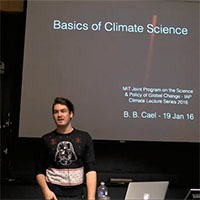
In January the 2016 MIT Independent Activities Period (IAP) featured two programs presented by Joint Program graduate students and postdoctoral fellows—one focused on climate science and policy, the other on challenges and opportunities in scaling up wind energy.
Organized by Joint Program graduate students, the Introduction to Climate Science and Policy program provided a fast-paced but accessible introduction to the earth’s climate system and the links between scientific and societal aspects of climate change. The program consisted of eight sessions on climate science and global and local climate policy, six of which are now available online.
Climate Science
Graduate students from the Department of Earth, Atmospheric and Planetary Sciences (EAPS) presented three sessions on climate science basics, the mechanisms of climate change, and uncertainties in global climate models.
In the lead-off session, B.B. Cael presented fundamentals of climate science, emphasizing solar radiation and greenhouse gases, the carbon cycle and earth’s heat storage.
“We can think of the Earth system as an energy balance, where the earth is trying to put out as much energy as what’s being taken in,” said Cael, “but that picture is complicated by greenhouse gases, which are pushing the energy that the earth is trying to let off back at the surface of the earth, and so the earth has to heat up in order to compensate.” He noted that while solar radiation, greenhouse gases and heat are simple phenomena, interaction and feedbacks among these and other elements of the climate system can be complex and difficult to predict.
In a companion session on the mechanisms of climate change, Mara Freilich illustrated the concept of a positive feedback loop. In one example, she noted that rising levels of carbon dioxide in the atmosphere boost radiation absorption, thereby increasing atmospheric temperature. This, in turn, produces more evaporation, which (since water is itself a greenhouse gas) increases radiation absorption and further heats the atmosphere. Freilich explored feedbacks and interactions among the water cycle, clouds, aerosols (volcanic and anthropogenic) and ocean circulation in the climate system.
Megan Lickley presented a session on climate change projections and uncertainty. Lickley focused on uncertainty in the rate of global warming, sea level rise and storm activity, and how everything from coarse time and space resolution to inaccurate representation of climate system feedbacks can propagate uncertainty in climate models.
Climate Policy
Three sessions explored climate policy, introducing participants to climate policy options, governance and action at the international, national and subnational levels.
One session led by Samantha Houston, a graduate student in the Technology and Policy Program (TPP), reviewed options for climate mitigation, adaptation and geoengineering. Houston’s talk centered on mitigation approaches to reduce greenhouse gas emissions, including regulation (e.g., through fuel economy standards), clean energy research and development subsidies, and putting a price on carbon. She observed that implementation of carbon pricing through a carbon tax or cap-and-trade policy can involve important tradeoffs.
“The carbon tax has a fixed cost per unit of carbon emitted, but it leaves uncertain the amount of emissions you’re going to end up with,” Houston said. “Cap-and-trade fixes the emissions amount, but you don’t know how much it’s going to cost to achieve those emissions.”
TPP graduate student Katie Mulvaney presented a session on international, national and subnational climate governance, with an emphasis on the Paris climate negotiations and national, regional and municipal climate action plans in the U.S. She described how climate policy instruments are chosen and enacted at each of these levels, and examined key challenges in implementing them. On the international level, Mulvaney noted that while the UN Paris climate talks resulted in an agreement among 196 countries to reduce GHG emissions considerably, their pledges are not legally binding and are projected to cap the rise in average global temperature since preindustrial times at around 3.5° Celsius, well above the international community’s 2°C target. The agreement does, however, call for a periodic global stocktake and subsequent ratcheting up of these commitments.
Finally, Freilich moderated a session on climate policy in action featuring a discussion with local leaders who are implementing creative solutions to climate change, from community activism to policy at the local and national scale.
Climate Negotiations Simulation and COP21 Recap
In a two-hour session led by Houston and Mulvaney, participants applied what they learned in an interactive international climate negotiations simulation designed to provide them with some insight into the challenges involved, and analyzed the outcome of the mock negotiation in real-time. The Climate Science and Policy program concluded with a panel discussion—cohosted by the MIT Energy Initiative and Joint Program and moderated by Institute for Data, Systems, and Society (IDSS) graduate student Amanda Giang—with members of the MIT community who participated as observers at the COP21 climate negotiations in Paris.
Scaling Up Wind Energy
Presented by Joint Program postdoctoral fellow Chiao-ting Li and IDSS graduate student Michael Davidson, the second program, “From Turbines to Tariffs: Technical and Regulatory Issues for Scaling Up Wind Energy,” covered the fundamentals of wind energy and how it integrates with electricity systems and regulatory structures (all presentations available online). Two sessions provided an overview of major issues in scaling up wind energy significantly in existing electricity systems, and two case studies from Li and Davidson’s research focusing on challenges and opportunities in China.
“As one of the lowest-cost and easily deployable low-carbon energy technologies, wind power plays a huge role in climate mitigation efforts,” said Davidson. “But policies cannot ignore the science behind wind’s variability and uncertainty, and engineering constraints of the electricity system. Addressing these concerns will require new approaches and a better understanding of how wind energy interacts in broader systems and markets.”
See new Joint Program webpage featuring Intro to Climate Science and Policy video series.
Photo: B.B. Cael presented a session on climate science fundamentals to lead off the Joint Program’s Introduction to Climate Science and Policy program, an offering of the 2016 MIT Independent Activities Period. (Photo by Dimonika Bray)

